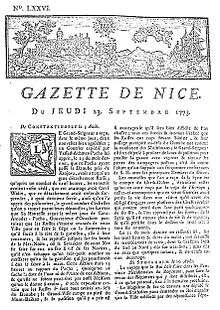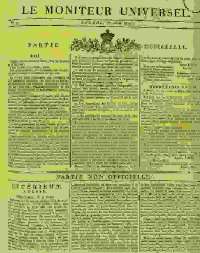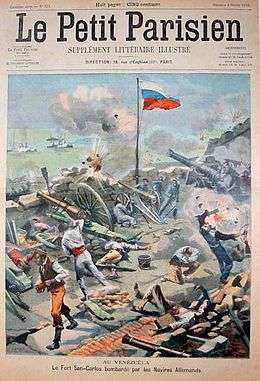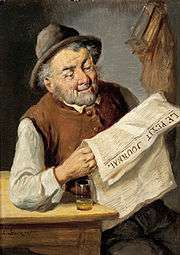History of French journalism

Newspapers have played a major role in French politics, economy and society since the 17th century.
Origins
The first French newspaper, Gazette (afterwards called the Gazette de France), started in 1615 under the patronage and with the active co-operation of Cardinal Richelieu. The first editor and printer was Théophraste Renaudot. The first weekly edition appeared in May 1631.[1] Each edition of the paper, which cost six centimes, consisted of a single sheet (folded into eight pages), and was divided into two parts. The first page was entitled Gazette, the second Nouvelles ordinaires de divers endroits. It commonly began with foreign and with national news. Much of its earliest foreign news came directly from the Cardinal, and often in his own handwriting.[2]
In 1672 Jean Donneau de Visé established the Mercure galant. Its title later changed to Nouveau Mercure (1717-1721), and in 1728 to Mercure de France, a designation retained, with minor modification, until 1853, when the paper finally ceased. It had many prominent contributors and in 1790 its circulation rose rapidly and reached a peak of 13,000 copies.[3]
Magazines
1789-1815: Revolutionary era
Between 1789 and 1799, over 1,300 new newspapers had appeared. By 1811 only four governmental authorities were allowed to publish news. This stifled French creativity and press.[4]

Under the Old regime, France had a small number of heavily censored newspapers which needed royal licenses to operate. The meetings of the Estates-General in 1789 fostered an enormous demand for news, and over 130 newspapers appeared by the end of the year. The next decade and the tumultuous events of the French Revolution saw 2000 newspapers founded, with 500 in Paris alone. Most lasted only a matter of weeks. Together they became the main communication medium, combined with the very large pamphlet literature.[5] Newspapers were read aloud in taverns and clubs, and circulated hand-to-hand. The French press saw for itself a lofty role: advancing civic republicanism based on public service; it downplayed the liberal, individualistic goal of making a profit.[6][7][8]

The Moniteur Universel served as the official record of legislative debates. Jean-Paul Marat gained enormous influence through his powerful L'Ami du peuple with its attacks on scandals and conspiracies that alarmed the people until he was assassinated in 1793. In addition to Marat, numerous important politicians came to the fore through journalism, including Maximilien de Robespierre and Jacques Hébert. In 1789, all restrictions on the press were eliminated; by 1793 over 400 newspapers had been founded, including 150 in Paris alone. During the conservative era of the Directory, from 1794 to 1799, newspapers declined sharply in importance. When Napoleon took power in 1799, only seventy-two papers were left in Paris, and he soon closed all but 13. In 1811 he took the final step: he allowed only four papers in Paris and one in each of the other departments; all of them closely censored.[9][10]
Under Napoleon, the organ of official information was the Moniteur (Gazette nationale, ou le moniteur universal), founded in 1789 under the same general management as the Mercure. Both newspapers were sources of establishment messages and written for an establishment audience, with the Moniteur representing the majority view in the French assembly and the Mercure representing the minority.[11]
1815-1871
The restoration of the Bourbons in 1815 allowed for a free press. After 1819, censorship was light, but there were restrictions such as the requirement to pay a large deposit with the government, And a stamp tax of five centimes on each copy. A handful of newspapers were published, closely aligned with political factions. They were expensive, sold only by subscription, and served by a small elite. [12]
In the mid-19th century, 1815-1880s, a series of technical innovations revolutionized the newspaper industry, and made possible mass production of cheap copies for a mass national readership. The telegraph arrived in 1845, and, about 1870, the rotary press developed by Hippolyte Auguste Marinoni. Previously, publishers used expensive rag paper and slow hand-operated screw presses. Now they used much cheaper wood pulp paper, on high-speed presses. The cost of production fell by an order of magnitude. The opening of the railway system in the 1860s that rapid distribution was possible between Paris and all the outline cities and provinces. As result of the technical revolution, much greater quantities of news was distributed much faster, and more cheaply. In June 1836 La Presse became the first French newspaper to include paid advertising in its pages, allowing it to lower its price, extend its readership and increase its profitability; other titles soon copied the formula.[13]
The revolution of 1848 gave rise to many ephemeral papers. However liberty of the press disappeared in 1851 under the Second Empire of Napoleon III. Most of newspapers were suppressed; each party was allowed only one paper. The severity of the censorship relax in the 1860s but did not end until the French Third Republic started in 1871.[14]
Le Correspondant founded in 1843 and published fortnightly, expressed liberal Catholic opinion, urged a restoration of freedom in France, resisted a growing anti-clericalism, and fought its conservative Catholic rival paper L'Univers. The paper clashed with government censors. In 1848 editors were convicted of "inciting hate and scorn of the government." The paper had many supporters and the emperor issued a pardon. In 1861 authorities forced the dismissal of a professor at the University of Lyons for an offensive article he wrote. The circulation was 3,290 in 1861, 5,000 in 1868, and 4,500 in 1869.[15][16]
Émile de Girardin (1806 – 1881) was the most successful and flamboyant journalist of the era, presenting himself as a promoter of mass education through mass journalism' His magazines reached over hundred thousand subscribers, and his inexpensive daily newspaper La Presse undersold the competition by half, thanks to is cheaper production and heavier advertising. Like most prominent journalists, Girardin was deeply involved in politics, and served in parliament. To his bitter disappointment, he never held high office. He was of brilliant polemicist, a master of controversy, with pungent short sentences that immediately caught the reader's attention. [17]
Modern France: 1871-1918

The new Third Republic, 1871-1914, was a golden era for French journalism. Newspapers were cheap, energetic, uncensored, omnipresent, and reflected every dimension of political life. The circulation of the daily press combined was only 150,000 in 1860. It reached 1 million in 1870 and 5 million in 1910. In 1914 Paris published 80 daily newspapers. Le Temps was the serious paper of record. Moderates additionally read Le Figaro. Catholics followed La Croix. Nationalists read L'Intransigeant. Socialists (and after 1920 Communists) took direction from "L'Humanité." Much more popular than any of these, and much less political, with nationwide circulation of a million or more came Le Petit Journal, Le Matin, and Le Petit Parisien. The heavy-handed censorship of the First World War, the conscription of journalists, and the severe shortage of newsprint, drastically undercut the size, scope, and quality of all the newspapers.[19]

Advertising grew rapidly, providing a steady financial basis that was more lucrative than single-copy sales. A new liberal press law of 1881 abandoned the restrictive practices that had been typical for a century. New types of popular newspapers, especially Le Petit Journal reached an audience more interested in diverse entertainment and gossip rather than hard news. It captured a quarter of the Parisian market, and forced the rest to lower their prices. In 1884, it added the Supplément illustré, a weekly Sunday supplement that was the first to feature color illustrations. In 1887, it boasted a daily circulation of 950,000, the highest of any newspaper in the world. In 1914. It sold 1.5 million copies a day across France. Most Frenchmen lived in rural areas, and traditionally had minimal access to newspapers. The illustrated popular press revolutionized the rural opportunities for entertaining and colorful news, and helped modernize traditional peasants into Frenchmen.[20][21]
The main dailies employed their own journalists who competed for news flashes. All newspapers relied upon the Agence Havas (now Agence France-Presse), a telegraphic news service with a network of reporters and contracts with Reuters to provide world service. The staid old papers retained their loyal clientele because of their concentration on serious political issues.[22]
The Roman Catholic Assumptionist order revolutionized pressure group media by its national newspaper La Croix. It vigorously advocated for traditional Catholicism while at the same time innovating with the most modern technology and distribution systems, with regional editions tailored to local taste. Secularists and Republicans recognize the newspaper as their greatest enemy, especially when it took the lead in attacking Dreyfus as a traitor and stirred up anti-Semitism. When Dreyfus was pardoned, the Radical government in 1900 closed down the entire Assumptionist order and its newspaper.[23]
Corruption
Businesses and banks secretly paid certain newspapers to promote particular financial interests, and hide or cover up possible most behavior. Publishers took payments for favorable notices in news articles of commercial products. Sometimes, a newspaper would blackmail a business by threatening to publish unfavorable information unless the business immediately started advertising in the paper. Foreign governments, especially Russia and Turkey, secretly paid the press hundreds of thousands of francs a year to guarantee favorable coverage of the bonds it was selling in Paris. When the real news was bad about Russia, as during its 1905 Revolution or during its war with Japan, it raised the bribes it paid to millions of francs. Each ministry in Paris had a group of journalists whom it secretly paid and fed stories.[24] During the World War, newspapers became more of a propaganda agency on behalf of the war effort; there was little critical commentary. The press seldom reported the achievements of the Allies; instead they credited all the good news to the French army. In a word, the newspapers were not independent champions of the truth, but secretly paid advertisements for special interests and foreign governments.[25]
Stagnation after 1914
Regional newspapers flourished after 1900. However the Parisian newspapers were largely stagnant after the war; circulation inched up to 6 million a day from 5 million in 1910. The major postwar success story was Paris Soir; which lacked any political agenda and was dedicated to providing a mix of sensational reporting to aid circulation, and serious articles to build prestige. By 1939 its circulation was over 1.7 million, double that of its nearest rival the tabloid Le Petit Parisien. In addition to its daily paper Paris Soir sponsored a highly successful women's magazine Marie-Claire. Another magazine Match was modeled after the photojournalism of the American magazine Life. [26]
France was a democratic society in the 1930s, but the people were kept in the dark about critical issues of foreign policy. The government tightly controlled all of the media to promulgate propaganda to support the government's foreign policy of appeasement to the aggressions of Italy and especially Nazi Germany. There were 253 daily newspapers, all owned separately. The five major national papers based in Paris were all under the control of special interests, especially right-wing political and business interests that supported appeasement. They were all venal, taking large secret subsidies to promote the policies of various special interests. Many leading journalists were secretly on the government payroll. The regional and local newspapers were heavily dependent on government advertising and published news and editorials to suit Paris. Most of the international news was distributed through the Havas agency, which was largely controlled by the government.[27]
Radio
Alternative news sources were likewise tightly controlled. Radio was a potentially powerful new medium, but France was quite laggard in consumer ownership of radio sets, and the government impose very strict controls. After 1938, stations were allowed only three brief daily bulletins, of seven minutes each, to cover all the day's news. The Prime Minister's office closely supervised the news items that were to be broadcast. Newsreels were tightly censored; they were told to feature none controversial but glamorous entertainers, film premieres, sporting events, high-fashion, new automobiles, an official ceremonies. Motion pictures likely likewise were censored, and were encouraged to reinforce stereotypes to the effect that the French were always lovers of liberty and justice, contending against cruel and barbarous Germans. The government-subsidized films that glorified military virtues and the French Empire. The goal was to tranquilize public opinion, to give it little or nothing to work with, so as not to interfere with the policies of the national government. When serious crises emerged such as the Munich crisis of 1938, people were puzzled and mystified by what was going on. When war came in 1939, Frenchman had little understanding of the issues, and little correct information. They suspiciously distrusted the government, with the result that French morale in the face of the war with Germany was badly prepared. [28]
Since 1940
The press was heavily censored during the Second World War; the Paris newspapers were under tight German supervision by collaborators; others were closed.[29] In 1944, the Free French liberated Paris, and seized control of all of the collaborationist newspapers. They turned the presses and operations over to new teams of editors and publishers, and provided financial support. Thus for example The previously high-prestige Le Temps was replaced by the new daily Le Monde.[30]
During the Fourth Republic from 1944 to 1958, Le Figaro Was in effect the official organ of the foreign ministry. French radio and television was under government ownership and strict supervision. Under the Fifth Republic, radio and television remained under strict control of the national government. Newspapers provided limited news of international affairs, and had little influence on government decisions.[31]
In the early 21st century, the best-selling daily was the regional Ouest-France in 47 local editions, followed by Le Progres of Lyon, La Voix du Nord in Lille, and Provençal in Marseille. In Paris the Communists published l'Humanite while Le Monde Figaro had local rivals in Le Parisien, L'Aurore and the leftist Libération.
See also
- History of journalism#France
- List of newspapers in France
- Media of France
- Office de Radiodiffusion Télévision Française, radio and TV
References
- ↑ Jeremy Popkin, The Press in France (1999)
- ↑ Charles Calvert, The French Newspaper (1933)
- ↑ Anthony Smith, The Newspaper: An International History (1979)
- ↑ Haine, Scott. The History of France (1st ed.). Greenwood Press. p. 92. ISBN 0-313-30328-2.
- ↑ Harvey Chisick, "The pamphlet literature of the French revolution: An overview." History of European ideas (1993) 17#2-3 pp: 149-166.
- ↑ Jane Chapman, "Republican citizenship, ethics and the French revolutionary press," Ethical Space: The International Journal of Communication Ethics (2005) 2#1 pp. 7–12
- ↑ H. Gough, The Newspaper Press in the French Revolution (1988)
- ↑ Jeremy Popkin, Revolutionary News: The Press in France 1789- 1799 (1990)
- ↑ Paul R Hanson, The A to Z of the French Revolution (2007) pp 233-35 online
- ↑ Robert Justin Goldstein (1989). Political Censorship of the Arts and the Press in Nineteenth-Century. Palgrave Macmillan UK. p. 55.
- ↑ David I. Kulstein, "The Ideas of Charles-Joseph Panckoucke, Publisher of the Moniteur Universel, on the French Revolution.," French Historical Studies (166) 4#3 pp 304-19
- ↑ J.P.T. Bury, France, 1814-1940 (1948) pp 26-27; John P. Wolf, France: 1814-1919: The Rise of a Liberal-Democratic Society (1940) p 51
- ↑ George T Kurian, World press encyclopedia (1982) 1: 341-42.
- ↑ Arthur Tilley, Modern France: A Companion to French Studies (1922) pp 181-82.
- ↑ Flavia Augustine, Le Correspondant: French liberal catholic journal, 1843-1855 (Catholic University of America Press, 1958).
- ↑ William E. Echard Historical Dictionary of the French Second Empire, 1852-1870 (1985) pp 143-44 online
- ↑ Joanna Richardson, "Emile de Girardin 1806-1881," History Today (1976) 26#12 pp 811-17.
- ↑ Weber, Peasants into Frenchmen (1976) p 464.
- ↑ Kurian, World press encyclopedia (1982) 1: 342.
- ↑ Eugen Weber, Peasants into Frenchmen: The modernization of rural France, 1870-1914 (1976) p 464.
- ↑ Gregory Shaya, "The Flaneur, the Badaud, and the Making of a Mass Public in France, circa 1860-1910." American Historical Review 109.1 (2004): 41-77 esp note 20 online.
- ↑ Patrick H, Hutton, ed. Historical Dictionary of the Third French Republic, 1870-1940 (1986) 2:690-94
- ↑ Judson Mather, "The Assumptionist Response to Secularisation, 1870-1900," in Robert J. Bazucha, ed., Modern European Social History (1972) pp: 59-89.
- ↑ John Keiger, France and the World since 1870 (2001) pp 37-38.
- ↑ See Theodore Zeldin, France: 1848-1945 (1977) vol 2 ch 11, "Newspapers and corruption" pp 492-573; pp 522-24 on foreign subsidies.
- ↑ Hutton 2:692-94
- ↑ Anthony Adamthwaite, Grandeur and Misery: France’s Bid for Power in Europe 1914-1940 (1995) pp 175-92.
- ↑ Adamthwaite, Grandeur and Misery: France’s Bid for Power in Europe 1914-1940 (1995) pp 175-92.
- ↑ Valerie Holman, "The Impact of War: British Publishers and French Publications 1940-1944," Publishing History (2000), Issue 48, pp 41-65.
- ↑ Clyde Thogmartin, The National Daily Press of France (1998) p 11
- ↑ Keiger, France and the World since 1870 (2001) p 39.
Further reading
Before 1945
- Blackburn, George M. "Paris Newspapers and the American Civil War." Illinois Historical Journal (1991): 177-193. in JSTOR
- Botein Stephen, Jack R. Censer and Ritvo Harriet. "The Periodical Press in Eighteenth-Century English and French Society: A Cross-Cultural Approach", Comparative Studies in Society and History, 23 (1981), 464-90.
- Censer, Jack Richard, and Jeremy D. Popkin, eds. Press and politics in pre-revolutionary France (U of California Press, 1987)
- Chalaby, Jean K. "Journalism as an Anglo-American Invention A Comparison of the Development of French and Anglo-American Journalism, 1830s-1920s." European Journal of Communication (1996) 11#3 pp: 303-326.
- Chalaby, Jean K. "Twenty years of contrast: The French and British press during the inter-war period." European Journal of Sociology 37.01 (1996): 143-159. 1919-39
- Chambure, A. de (1914). A travers la presse (in French). Paris: Fert, Albouy & cie.
- Collins, Ross F. "'Cossacks Marching to Berlin!': A New Look at French Journalism during the First World War." American Journalism 18 (Fall 2001), 29-44.
- Collins, Irene. The government and the newspaper press in France, 1814-1881 (Oxford University Press, 1959)
- Collins, Ross F. "Newspapers of the French Left in Provence and Bas-Languedoc during the First World War," (PhD dissertation, University of Cambridge, 1992) online
- Collins, Ross F. "The Business of Journalism in Provincial France during World War I." Journalism History 27 (2001), 112-121.
- Collins, Ross F., and E. M. Palmegiano, eds. The Rise of Western Journalism 1815-1914: Essays on the Press in Australia, Canada, France, Germany, Great Britain and the United States (2007), Chapter on France by Ross Collins
- Cragin, Thomas J. "The Failings of Popular News Censorship in Nineteenth-Century France." Book History 4.1 (2001): 49-80. online
- Darnton, Robert, and Daniel Roche, eds. Revolution in print: the press in France, 1775-1800 (University of California Press, 1989) online
- Edelstein, Melvin. "La Feuille villageoise, the Revolutionary Press, and the Question of Rural Political Participation." French Historical Studies (1971): 175-203. in JSTOR
- Eisenstein, Elizabeth L. Grub Street Abroad: Aspects of the French Cosmopolitan Press from the Age of Louis XIV to the French Revolution (1992)
- Freiberg, J. W. The French press: class, state, and ideology (Praeger Publishers, 1981)
- Goldstein, Robert Justin. "Fighting French Censorship, 1815-1881." French Review (1998): 785-796. in JSTOR
- Gough, Hugh. The Newspaper Press in the French Revolution (Routledge, 1988)
- Grimont, Ferdinand (1835). Manuel-annuaire de l'imprimerie, de la librairie et de la presse (in French). Paris: P. Jannet.
- Harris, Bob. Politics and the Rise of the Press: Britain and France 1620-1800 (Routledge, 2008)
- Isser, Natalie. The Second Empire and the Press: A Study of Government-Inspired Brochures on French Foreign Policy in Their Propaganda Milieu (Springer, 1974)
- Kerr, David S. Caricature and French Political Culture 1830-1848: Charles Philipon and the Illustrated Press (Oxford University Press, 2000)
- de la Motte, Dean, and Jeannene M. Przyblyski, eds. Making the News: Modernity and the Mass Press in Nineteenth-Century France (1999). essays by scholars from several disciplines online
- Olson, Kenneth E. The history makers: The press of Europe from its beginnings through 1965 (LSU Press, 1966), pp 167-93, 438-39
- Pettegree, Andrew. The invention of news: How the world came to know about itself (Yale UP, 2014).
- Popkin, Jeremy D. "The Press and the French revolution after two hundred years." French Historical Studies (1990): 664-683 in JSTOR
- Sterling, Christopher H., ed. Encyclopedia of Journalism (6 vol. 2009) table of contents
- Thogmartin, Clyde. The national daily press of France (Birmingham Alabama: Summa Publications, Inc., 1998), 370pp; Comprehensive scholarly history
- Trinkle, Dennis A. The Napoleonic press: the public sphere and oppositionary journalism (Edwin Mellen Pr, 2002)
- Weigle, Clifford. "The Paris Press from 1920 to 1940" Journalism Quarterly (1941) 18: 376-84.
- Weigle, Clifford. "The Rise and Fall of the Havas News Agency" Journalism Quarterly (1942) 19:277-86
- Williams, Roger Lawrence. Henri Rochefort, prince of the gutter press (Scribner, 1966)
- Zeldin, Theodore France: 1848-1945 (1977) vol 2. ch 11, "Newspapers and corruption" pp 492-573
- Zerner, Elisabeth H. "Rumors in Paris Newspapers," Public Opinion Quarterly (1946) 10#3 pp. 382-391 in JSTOR In summer 1945
Recent history
- Albert, Pierre. La Presse Française [The French Press]. (Paris: La documentation française 2004).
- Benson, Rodney, and Daniel Hallin. “How States, Markets and Globalization Shape the News: The French and US National Press, 1965–97.” European Journal of Communication (2007) 22#1 27–48.
- Benson, Rodney, et al. "Media Systems Online and Off: Comparing the Form of News in the United States, Denmark and France." Journal of Communication (2012) 62#1: 21–38
- Chalaby, Jean K. The de Gaulle presidency and the media: statism and public communications (Basingstoke: Palgrave Macmillan, 2002).
- Delporte, Christian. "Sarkozy and the Media." Contemporary French and Francophone Studies 16.3 (2012): 299-310.
- Eisendrath, Charles R. "Politics and Journalism--French Connection." Columbia Journalism Review 18.1 (1979): 58-61.
- Esser, Frank, and Andrea Umbricht. "Competing models of journalism? Political affairs coverage in US, British, German, Swiss, French and Italian newspapers." Journalism 14#8 (2013): 989-1007.
- Kuhn, Raymond (2006). The Media in France. Routledge., wide-ranging survey; bibliography (mostly in French) pp 169-79. excerpt.
- Kuhn, Raymond. "What's so French about French Political Journalism." in Kuhn, Raymond, and Rasmus Kleis Nielsen, eds. Political Journalism in Transition. Western Europe in a Comparative Perspective (2014): 27-46.
- Powers, Matthew, and Rodney Benson. "Is the internet homogenizing or diversifying the news? External pluralism in the US, Danish, and French press." International Journal of Press/Politics 19#2 (2014): 246-265. online
- Sterling, Christopher H., ed. Encyclopedia of Journalism (6 vol. 2009) table of contents
- Thogmartin, Clyde (1998). The National Daily Press of France. Summa Publications., 370pp; comprehensive scholarly history